My post about why you should never eat vegetable oil or margarine talked about the important ratio of Omega-3 (n-3) and Omega-6 (n-6) fats in the body, but this topic is important enough to deserve its own post.
Vegetable oils are dangerous for many reasons, including that they can easily go rancid, they are processed with chemicals, and they can turn in to trans fats when heated. Vegetable oils are also high in Omega-6 fats and proportionately low in Omega-3 fats. Why does this matter?
Omega-3 Fats
Omega-3 fats have gotten a lot of good press for their many benefits to the body and with good reason. The University of Maryland Medical Center explains that Omega-3 fatty acids may be useful for:
- Reducing the risk of heart disease and causes of death associated with heart disease
- Reducing severity of symptoms associated with diabetes
- Reducing pain associated with rheumatoid arthritis
- Reducing risk of osteoporosis and bone loss
- Improving health and reducing symptoms for those with autoimmune disease
- Helping those with anxiety, depression or bipolar disorder
- Reducing risk of various types of cancers
- Improving cognitive function
The body does not make Omega-3 fatty acids so they must be obtained from foods. As this article from the Harvard School of Public Health explains:
“There are two major types of omega-3 fatty acids in our diets: One type is alpha-linolenic acid (ALA), which is found in some vegetable oils, such as soybean, rapeseed (canola), and flaxseed, and in walnuts. ALA is also found in some green vegetables, such as Brussels sprouts, kale, spinach, and salad greens. The other type, eicosapentaenoic acid (EPA) and docosahexaenoic acid (DHA), is found in fatty fish. The body partially converts ALA to EPA and DHA.”
It has often been assumed that either source (plant or fish) is sufficient, but Chris Kresser shows why this is not the case:
However, research clearly indicates that the conversion of ALA to EPA and DHA is extremely limited. Less than 5% of ALA gets converted to EPA, and less than 0.5% (one-half of one percent) of ALA is converted to DHA.
In other words: while it is a great idea to eat green leafy vegetables (which provide ALA), it is also important to consume fatty fish as a source of EPA and DHA. Science has shown that EPA and DHA are especially important while pregnant and many prenatal vitamins contain them, but it is preferable to obtain them from food.
“Several other observations support the hypothesis that DHA is essential:
- DHA content in the tissues of all mammals is very similar despite widely varying intakes of omega-3 fatty acids. 1
- DHA and AA, but not other omega-3 or omega-6 fatty acids, are selectively transferred across the placenta
- 60% of the dry matter of the brain is lipid, and DHA and AA are the most abundant fatty acids of brain phospholipids
- DHA status in newborns is much lower in those receiving formula with LA and ALA, than in those receiving milk or formula with pre-formed DHA”
It is pretty well established that Omega-3 fats are important for health, but how much should a person take and what is the best way to obtain these fats? That actually depends on the amount of Omega-6 fatty acids in the diet:
Omega-6 Fats
Scientists estimate that our ancestors consumed Omega-6 and Omega-3 fats in a ratio of close to 1:1. As vegetable oil consumption and processed grain consumption have risen, so has the ratio of n-6 to n-3 fats.
Vegetable oils are very high in Omega-6 fats:
- Safflower oil is 75% Omega-6 and 0% Omega-3
- Sunflower, Corn, Cottonseed and Soybean oils are all more than 50% Omega-6 fats with 0% Omega-3s
- Fish oils are 100% Omega-3 and 0% Omega-6
Think about how many foods the average American consumes that contains vegetable oils, soy or processed grains compared to foods that contain fatty fish or fish oils. It is easy to see why it is now estimated that we consume (on average) a 12:1 ratio of n-6 to n-3 foods.
Why the Ratio Matters
Chris Kresser explains that Omega-3s and Omega-6s compete for the enzymes needed for digestion and that:
“In plain english, what this means is that the more omega-3 fat you eat, the less omega-6 will be available to the tissues to produce inflammation. Omega-6 is pro-inflammatory, while omega-3 is neutral. A diet with a lot of omega-6 and not much omega-3 will increase inflammation. A diet of a lot of omega-3 and not much omega-6 will reduce inflammation.”
As I showed in previous posts about vegetable oil consumption and heart disease, as rates of vegetable oil and sugar consumption have risen, so have rates of heart disease and many other health problems (in fact, the graphs look almost identical). During this same time, consumption of foods that contain saturated fats and Omega-3 fats has decreased:
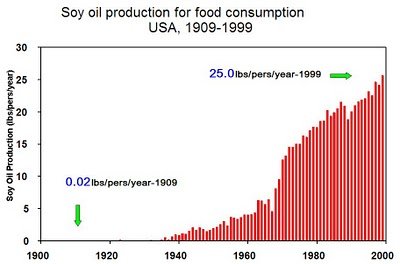
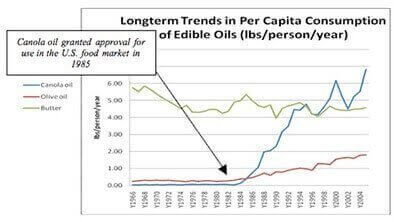
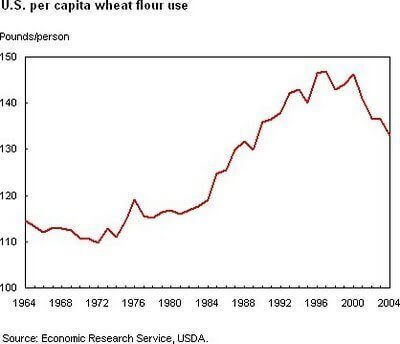
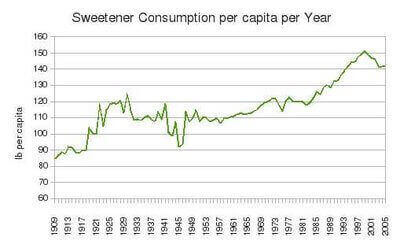
At the same time, this happened:

Of course, correlation doesn’t equal causation, but it worth a second look when we have rising rates of heart disease, cancer, obesity and many other health problems.
Chris Kresser (seriously, go read his entire site) sums it up perfectly:
“The relationship between intake n-6 fats and cardiovascular mortality is particularly striking. The following chart, from an article entitled Eicosanoids and Ischemic Heart Disease by Stephan Guyenet, clearly illustrates the correlation between a rising intake of n-6 and increased mortality from heart disease:
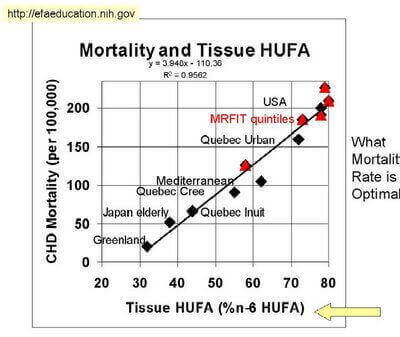
As you can see, the USA is right up there at the top with the highest intake of n-6 fat and the greatest risk of death from heart disease.
On the other hand, several clinical studies have shown that decreasing the n-6:n-3 ratio protects against chronic, degenerative diseases. One study showed that replacing corn oil with olive oil and canola oil to reach an n-6:n-3 ratio of 4:1 led to a70% decrease in total mortality. That is no small difference.”
The Bottom Line
It is important to get Omega-3 fats and Omega-6 fats in a healthy balance, and as close to a 1:1 ratio as possible. This can certainly be difficult with out modern food supply and many doctors and health practitioners recommend taking an Omega-3 supplement if needed.
Personally, I try to eat fatty fish at least once or twice a week and I take supplemental forms of Omega-3 from quality sources, especially when pregnant or nursing. Some other steps that can help this ratio (and overall health:
- Avoid Vegetable Oils and Products Containing Them– These oils mess up the balance of protective Omega-3 fatty acids and potentially dangerous Omega-6 fatty acids in the body. They also contribute to inflammation and arterial damage. There is no reason that you need to consume these oils at any point… ever!
- Eat Lots of Saturated Fats and Other Healthy Fats– As studies have yet to link saturated fat intake with heart disease, and in fact, many prove the opposite, getting enough saturated fat from sources like animal fats, coconut oil, raw organic dairy, etc is essential to give the body all the building blocks it needs for proper cell and hormone function.
- Optimize Vitamin D and Fat Soluble Vitamins- Fat soluble vitamins in proper amounts in the body have a protective effect on tissues and organs (including the heart). If you’ve been on a law-fat diet or used sunscreen all your life, you could be seriously deficient in vitamin D, so consider getting your blood levels tested.
- Get Enough Omega-3s- These help balance out the Omega-6 to Omega-3 ratio in the body and prevent inflammation. Omega-3s also can thin the blood and keep it from clotting too regularly, a risk factor in heart disease. Having a proper Omega-3 balance also helps keep triglyceride levels in check.
- Exercise– You’ve heard this one before, yet most of us don’t get enough exercise in. Exercise helps strengthen the heart and tone muscles. It increases circulation and reduces stress hormones- all good things to help reduce your risk of heart disease.
- Reduce Stress and Get Enough Sleep– High stress levels and lack of sleep can both increase inflammation and stress hormones in the body. Both are also linked to higher levels of many diseases, including heart disease, and increased overall mortality.
Do you take Omega 3 or Omega 6? Share below!

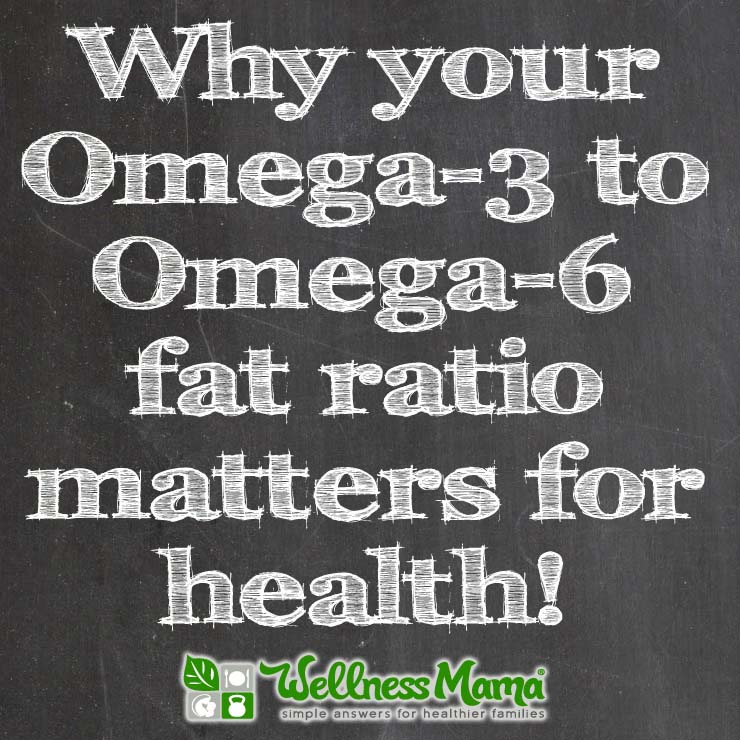
Leave a Reply